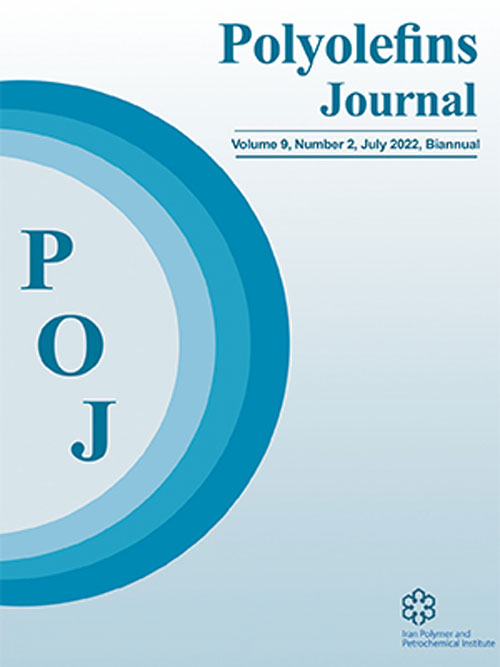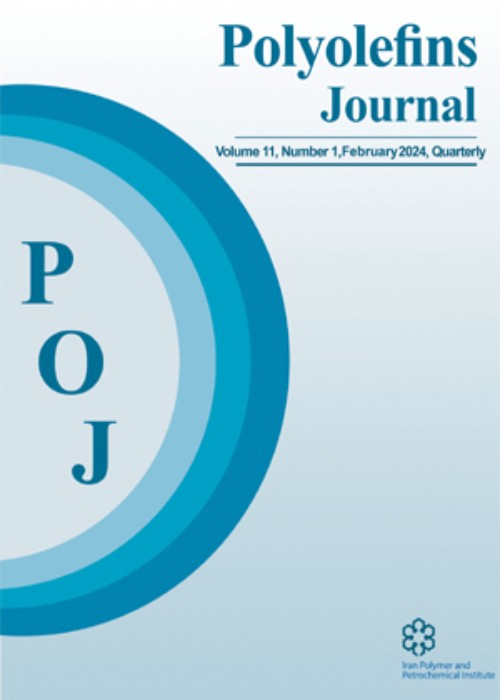فهرست مطالب

Polyolefins Journal
Volume:9 Issue: 2, Summer-Autumn 2022
- تاریخ انتشار: 1401/04/11
- تعداد عناوین: 9
-
-
Pages 73-83Researchers have studied the possibility of various polymer composites for radiation shielding applications. Lightness and non-toxicity of these materials are their significant advantages compared to Pb base traditional and common shields. In this research, polyethylene (HDPE)-based composites for shielding against X-ray radiations were prepared by utilizing several weight fractions of the nano tungsten oxide, bismuth oxide, and barium sulfate, which were decorated on nanographene oxide (10, 15, 20, and 25 wt%). The linear and mass attenuation coefficient values of samples were investigated experimentally with an X-ray tube at radiology energy ranges and estimated theoretically by using MCNP code (Mont Carlo Nanoparticle program). Results illustrate that by increasing the nanoparticles content, the linear attenuation coefficient parameter and the absorbed dose values increased dramatically. The shielding efficiency of the prepared samples has been shown by measuring the HVL values. Furthermore, the effect of sample thicknesses on the attenuation properties of nanocomposites was studied in this research. The morphological properties of the samples were evaluated with SEM. The collected results showed that the particle size of the nanoparticles used has a uniform dispersion in the polymer matrix. The mechanical properties of nanocomposite samples were characterized by DMTA and tensile test. Nanocomposites containing 20% and 25% of tungsten oxide and bismuth oxide particles reached to 88% and 90% dose absorption, respectively.Keywords: Shielding, polyethylene, Nanocomposite, linear attenuation, tungsten
-
Pages 85-91This study was designed to investigate the effect of molar ratio of 1-octene and type as well as concentration of Lewis acids on the free radical copolymerization of butyl methacrylate (BMA) with 1-octene. The synthesized copolymers have been substantially described by FTIR, 1H NMR, GPC and DSC. The quantitative 1H NMR and GPC demonstrated that by increase in the molar ratio of 1-octene and Lewis acids to BMA, the incorporation of 1-octene in the copolymer backbone enhanced, Mn reduced and polydispersity became narrower. The maximum incorporation of 1-octene (13.7%) was observed for sample CSC7 having [1-octene/BMA] of 3 mol% and [AlCl3/BMA] of 1.5 mol%. The DSC results confirmed the NMR and GPC outcomes, suggesting a decrease in Tg by increasing 1-octene in the copolymer backbone. Moreover, it is found that temperature has a remarkable influence on the copolymerization behavior. The results also showed that by substituting the acrylate monomer from butyl methacrylate to butyl acrylate, the incorporation of 1-octene increased.Keywords: copolymerization, Butyl methacrylate, 1-octene, monomer incorporation, Lewis acid
-
Pages 93-101In this work, the interaction between a polystearylmethacrylate (Mn = 8,900 g mol-1, Xn = 26, Ð = 1.1) and modified methylaluminoxane 12 (MMAO-12) co-catalyst is studied using different spectroscopic methods. The effect of this oxygen-donor additive was measured by the changes in the bulk density of the raw polyethylene, which resulted increased respect to those obtained in blank reactions. A decrease in the activity was also observed as a penalty for the improvement of the bulk density, enhancing the possibility of reducing fouling. The coordination of the carbonyl oxygen groups of polystearylmethacrylate to aluminum (III) centers is confirmed by 1H-NMR and FTIR studies, and by a simple semi-empirical computational calculation. A method for obtaining a tri-component co-catalyst mixture is described using the methyl-bridging capacity of trimethylaluminum and its Lewis acidity to get the polystearylmethacrylate and MMAO-12 linked together. This robust adduct introduces a hierarchy over the PE chain growing, leading to higher bulk densities for PE beads (0.43 g cm-3) concerning blank reactions (0.26 g cm-3).Keywords: metallocene catalyst, oxygen donors, Methylaluminoxane, Ethylene polymerization, bulk density
-
Pages 103-116For preparation of highly active supported catalyst with bis(imino)pyridyl Fe(II) complexes (Fe1, Fe2) and N,N-α-diimine complex of Ni (Ni3), silica modified with alumina (SiO2 (Al)) was used as a support. Data on the possibility to regulate molecular weight (MW) and molecular weight distribution (MWD) of polyethylene (PE), produced over the supported catalyst Fe1/SiO2 (Al)+TIBA by variation of polymerization temperature and the addition of hydrogen and hexene-1, are obtained. The prepared PE samples were characterized by Mw values varied from 80 to 350 kg/mol and various MMD (Mw/Mn=4.6-11.7).By grafting on SiO2(Al) of two different iron bis(imino)pyridyl complexes, producing PE with diverse MW, bi-component catalyst was prepared. This catalyst generates linear PE with broad and bimodal MWD (Mw/Mn=33). Fixation on SiO2(Al) of α-diimine Ni(II) pre-catalyst (Ni3), yielding high molecular weight branched PE at the ethylene homopolymerization, and bis(imino)pyridyl Fe(II) complex (Fe2) that forms lower molecular weight linear PE, affords formation of a new bi-component catalyst. The catalyst produces PE with broad MWD and high content of branches concentrated in high molecular weight PE fraction.Keywords: Ethylene polymerization, supported catalysts, bis(imino)pyridyl complex of Fe, diimine complex of Ni, molecular weight distribution
-
Pages 117-127Ziegler-Natta catalyst for propylene polymerization, which TiCl4 and di-alkyl phthalate were supported on MgCl2, was analyzed by solid state 13C NMR. It was confirmed that the spin-lattice relaxation time (“relaxation time” hereafter) of carbonyl group in phthalate was shortened with increasing measurement temperature as a general manner because of the enhancing of molecular mobility at high temperature. The degree of the relaxation period reduction with temperature was influenced by the alkyl group size in phthalate molecule; the larger alkyl group showed a greater shorting of the relaxation period. A short relaxation time should suggest a weak interaction between the phthalate molecule and the MgCl2 support surface. The change in catalytic performance was discussed by the active site formation mechanism involving the phthalate removal step.Keywords: Ziegler-Natta catalyst, propene polymerization, solid-state 13C NMR, spin-lattice Relaxation time, carbonyl(C, O) motion in phthalate molecular
-
Pages 129-138Rotational molding is a process used to produce seamless, one-piece, and hollow polymeric parts. Foam rotational molding has recently become an increasingly important process in the foam industry. However, foam rotational molding is still a challenging process to fabricate polymeric foams. The focus of this manuscript was to assess the effect of material parameters on the foam properties of samples produced by rotational molding. Rotational molding experiments were performed on a laboratory-scale two-axis rotational machine, designed and manufactured by the authors. The effects of microtalc as nucleating agent, nanoclay as reinforcing agent, and their synergetic effect were investigated on the cell density, cell size, and expansion ratio of hybrid microtalc/nanoclay polyethylene nanocomposites. The cell density was improved by 96% and 89% by addition of 1 wt% of microtalc and nanoclay, respectively, compared to pure polyethylene foams. The cell size was reduced by 20% and 17.5% in 1 wt% of microtalc and nanoclay, respectively. However, the synergetic effect of using both microtalc and nanoclay at 1 wt% was more significant compared to their individual effects. The cell density was enhanced by 313% and the cell size was decreased by 35% compared to pure samples.Keywords: Foam rotational molding, microtalc, Nanoclay, synergistic effect, cellular structure
-
Pages 139-149A copolymerization reaction was carried out by adding different contents of 5-ethylidene-2-norbomene or cyclopentene to dicyclopentadiene (DCPD) using an optimized polymerization process. The effects of different amounts of the comonomers on the conversion, mechanical properties and thermal stability of the polymer products were investigated and compared. The results showed that the addition of 5-ethylidene-2-norbomene accelerated the reaction rate and had little effect on the overall conversion rate of the reaction, while the addition of cyclopentene decreased the reaction rate and conversion rate. The tensile modulus, tensile strength, flexural modulus and flexural strength of the copolymer showed a trend of increasing and then decreasing with the increase of the comonomers content, reaching a peak at 5wt% of 5-ethylidene-2-norbomene or 3wt% of cyclopentene. At this peak condition, its impact strength could be improved by 50% compared to DCPD homopolymer. Below this peak condition, the Tg and thermal stability of the copolymer did not change significantly.Keywords: polydicyclopentadiene, 5-ethylidene-2-norbornene, cyclopentene, copolymerization reaction
-
Pages 151-162In this paper, the polymerization process of polydicyclopentadiene (PDCPD) obtained by using dicyclopentadiene (DCPD) and the 2nd generation Grubbs’ catalyst is optimized. The curing reaction kinetics was studied by differential scanning calorimetry (DSC), and the solidification reaction process was obtained. The effects of different ratios of monomer to catalyst on the product performance were investigated. In addition, the current common modification methods of PDCPD have been summarized and improved. The results showed that with the increase of the ratio of monomer to the catalyst, the tensile strength, tensile modulus, bending strength and bending modulus of PDCPD all showed a downward trend, and the impact strength showed an upward trend. When nDCPD: nCat =10000:1, the comprehensive mechanical properties of PDCPD reached the best. The bending modulus, tensile strength and impact strength of PDCPD achieved 2100 MPa, 52.4 MPa and 30 kJ/m2, respectively. The glass transition temperature (Tg) of PDCPD also showed a decreasing trend with the increase of the ratio of monomer to the catalyst, at this ratio, the Tg of the polymer reached 147.6°C. The catalyst concentration had a large effect on the product performance.Keywords: polydicyclopentadiene, Kinetics(polym.), Catalyst concentration, reaction injection moulding, ROMP
-
Pages 163-174In this study, for the first time, a novel strategy for the synthesis of graft copolymers using polystyrene (PSt) monomer from surface modification of poly(ethylene terephthalate) PET through surface-initiated nitroxide-mediated radical polymerization was performed. For this purpose, the PET surface was first aminated by 1,3-diamino propane, which was used as an amination agent. Second, phenyl chloro acetylation of PET was prepared by coupling amino and hydroxyl groups with α-phenyl chloro acetyl chloride. Afterward, 2,2,6,6-tetramethyl-1-piperidinyloxy (TEMPO) was synthesized, then 1-hydroxy-2,2,6,6-tetramethylpiperidine (TEMPO–OH) was obtained by reduction of TEMPO with sodium ascorbate and coupled with chloroacetylated PET to obtain PET-TEMPO macroinitiator. Furthermore, the (St) monomer was grafted onto the PET surfaces through the “grafting from” technique. The obtained macroinitiator for living radical polymerization was heated in the adjacency of (St) monomer to obtain the graft copolymer (PET-g-PSt) onto the PET surfaces. Finally, PET-g-PSt/MMt nanocomposite was synthesized by the solution intercalation method. The surface combination, morphology, and thermal properties of the modified PET films were proved using various characterization methods such as transform infrared spectroscopy (FT-IR), 1H nuclear magnetic resonance (1H NMR), differential scanning calorimetry (DSC), thermogravimetric analysis, X-ray photoelectron spectroscopy, and termination electron microscopy (TEM).Keywords: Nitroxide-Mediated Radical Polymerization (NMRP), TEMPO, Poly (ethylene terephthalate) (PET), Surface-initiated Polymerization, graft copolymer


